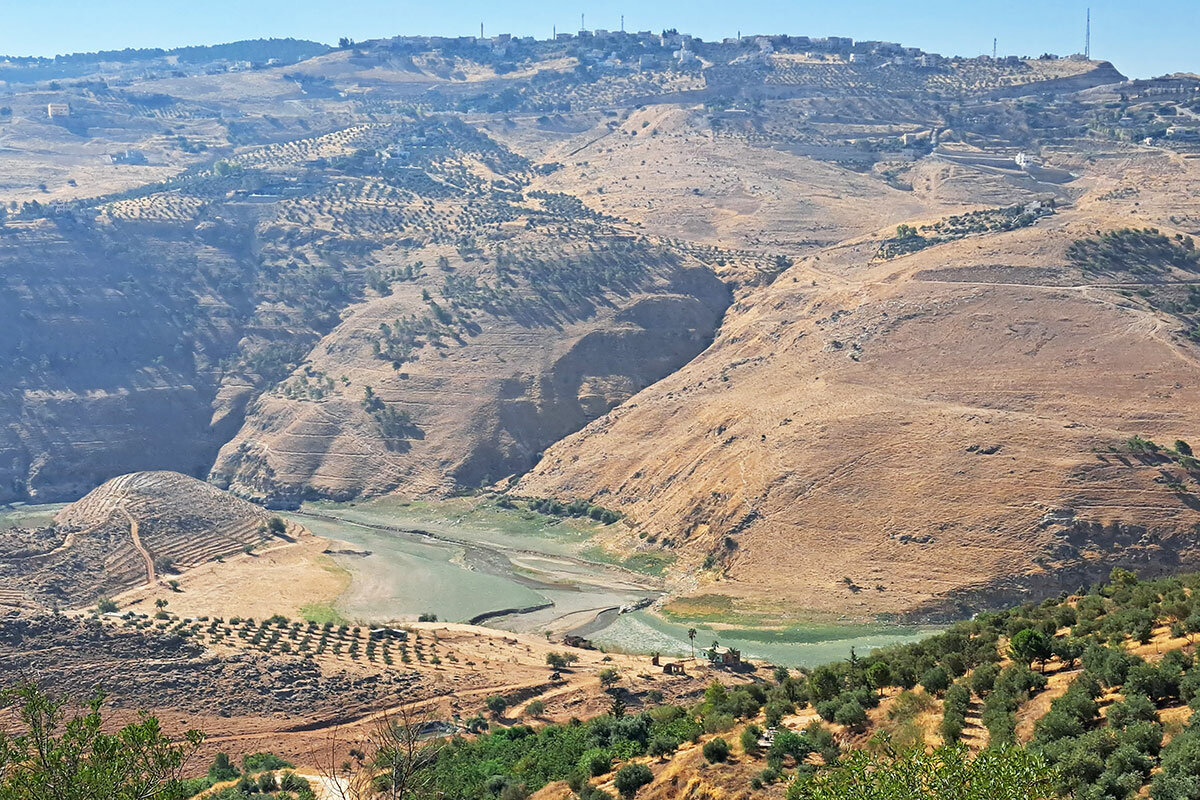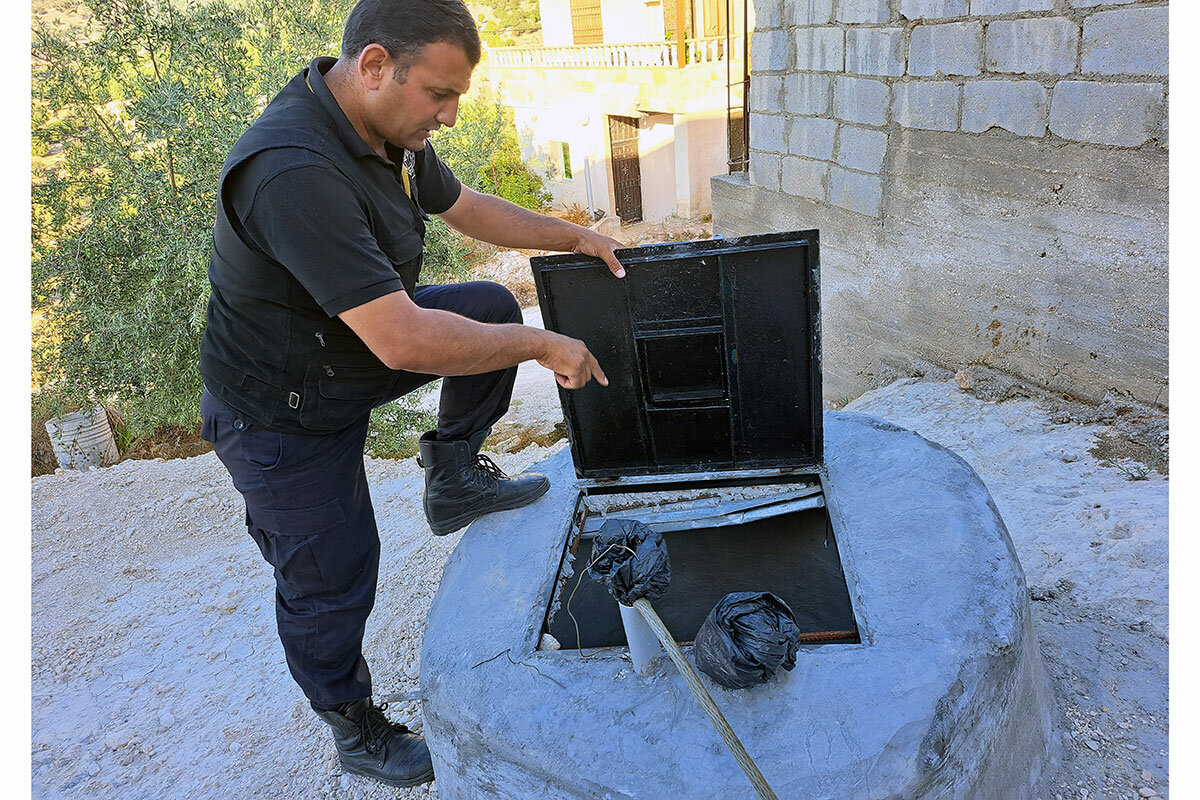Water: Lessons in survival from a bone-dry land
Loading...
| Al Koura and Jerash, Jordan
In towns and cities across Jordan, “water day” announces itself with a cacophony of high-pitched screeches filling the air.
Motors groan and strain to pump a trickle of water from ground-level pipes up five stories to aluminum and plastic rooftop storage tanks – tanks that will hold a family’s water for an entire week or more.
Families race to and fro across their apartments to run the pumps, do laundry, wash dishes, and water the garden before their 12-hour period is up. If they miss it, they have to wait until the next week – or perhaps weeks – for the next trickle.
Why We Wrote This
A story focused onThere’s drought, and then there’s Jordan. Lacking water all the time – their country is the second-most water-poor in the world – Jordanians rely on resourcefulness to cope with a lack of resources.
“Water day is more important than an anniversary or birthday in our household,” says Um Uday, a working mother of five in West Amman. “Managing water use has become a sacred duty.”
In Jordan, the second-most water-poor country in the world, people have long learned to live without the constant running water that most American families take for granted.
Yet the dwindling resources due to climate change and population growth mean the most effective innovation in parched Jordan is not novel water distribution schemes, technology, or dam construction – but how people change their daily lives to get the most out of each drop.
With Jordanians doing more with less, their resourcefulness is reliable – even when their water supply isn’t.
In largely arid Jordan, water resources are less than 90 cubic meters (almost 24,000 gallons) per person annually, a fraction of the 500 cubic meters (about 132,000 gallons) per capita the United Nations defines as “absolute water scarcity.”
Instead of supplying constantly running water, authorities release water through networks to a given village or neighborhood for one day on a weekly or twice-monthly basis as part of a rotation.
The water distribution schedule is designed to distribute water equally in different parts of the country, without waste, while maximizing the rapidly diminishing reserves in aquifers and rainwater reservoirs.
Solutions to the dire shortage range widely across the country.
Suleiman, a retired air force officer who gave only his first name, stops his pickup at a roadside natural spring in the village of Souf, 35 miles north of Amman, to fill containers for his thirsty flock of sheep.
As they have for generations, area residents come to this spring to stock up on water for livestock or washing; a second, purer, cold-water spring 2 miles up the hill is used for drinking water.
With official water distributed to the village for a few hours once a month in the summer, these springs have become a main source.
“We get water from this spring, utilize what we have in home wells,” Suleiman says, wiping his brow from the noon sun. “We have to make the most of each water source we have.”
Tough summer
Yet this year has been particularly hard; Jordan’s Ministry of Water and Irrigation described 2022 as “the most difficult year” yet.
A shift in weather patterns means Jordan is witnessing a slight decline in rainfall. The rainfall it now receives occurs in intense, shorter time periods in concentrated areas, leaving its network of dams struggling to catch the torrential runoff.
The dams are dry or nearing dry; green patches of earth mark where once mighty reservoirs stood.
Plans to desalinate seawater at Aqaba, the nation’s only port, are two decades off at best and are costly due to the immense energy needed to pump the water 200 miles through hilly topography to Amman, where 40% of the population lives.
With the capital getting priority for dam and aquifer water, towns and villages north and south of Amman bear the brunt of shortages – often going months without fresh supplies as summer demand spikes.
Um Mohamed, a widowed mother of four in Bayt Idis, a hilly, tree-dotted village in northern Jordan, heads one of thousands of households going without state-supplied water for the summer.
On this day she purchased from a licensed private well 3 cubic meters (792.5 gallons) for $21 – enough for her family’s weekly consumption, but taking 15% of her monthly income. She will try to make it last one month.
Like many, she is sticking to tried-and-true methods to stretch out each drop.
She does the dishes in a single bucket of water placed in the sink, careful not to splash out of the bucket. Once she soaps and rinses the pots, dishes, and silverware, she pours the food-clouded water onto a few of her plants, watering in a rotation.
Showers are timed and scheduled. Laundry is hand-washed in a large plastic basin utilizing the same water.
Her backyard is dotted with jugs and buckets filled with water from her purchase; they will be used to water the plants and wash the floors over the next two weeks.
“We have entire summers where we don’t get water from authorities, so we have to rely on ourselves,” she says. “If we don’t manage what we consume, then we consume ourselves.”
Business opportunities
For buyers like Um Mohamed, there are sellers for whom the water shortage has created new business opportunities.
Even urban dwellers who subscribe to government-supplied water and who have modified their consumption habits must often resort to private-sector solutions.
Akram Adheibat and his team of six are on call 24 hours a day.
Their High Springs Water Delivery, one of dozens of water companies that have popped up across Jordan, draws water from government-licensed wells, purifies it through reverse osmosis, and delivers it to businesses and households.
Since they opened in 2014, the company has a roster of 170 subscription customers across the town of Jerash, north of Amman, while dozens more call them day or night when their taps suddenly run dry.
Households across the country rely on businesses like theirs, purchasing 20 liters of drinking water for $1.50.
“Water is a good business in Jordan,” Mr. Adheibat says, “because it is an essential need.
New view of charity
Water shortages are also changing the way Jordanians view charity; charitable associations here have long provided food packages and cash assistance to low-income families.
Fadi Al Miqdadi, who faced his own water shortages and staggering bills for private supplies, sees a solution in family-owned wells. He is urging wealthy citizens to dig deeper for charity – literally.
“Cash assistance helps a family for a week, maybe two, but it isn’t a long-term solution,” Mr. Al Miqdadi says. “A well is forever.”
His Golden Spikes Association is working to dig rainwater wells for water- and cash-strapped families across northern Jordan. It built 100 in 2021 and 18 so far this year.
The price tag for a single household well runs to $2,800, a princely sum for families living on $310 to $500 a month. Mr. Al Miqdadi’s association, which bought heavy equipment and machinery and employs a team of experienced volunteers, offers to build a well for free. It asks families to cover only the $700 in raw materials; if they cannot, the association donates the materials as well.
Each 50 cubic meter well, fed by winter’s rainwaters, is enough to provide for a family of five’s needs for three to four months, or the entirety of summer. The wells would save families hundreds of dollars each year in private water they no longer have to purchase.
Um Mohamed, a recipient of a well this summer, is waiting for winter rains to fill the reservoir for the first time.
“Water is a blessing,” says Mr. Al Miqdadi. “Jordanians are always ready to donate to build a mosque. Why not donate to improve the living conditions of families for a lifetime?”
Munir Asasfeh, a Golden Spikes volunteer, built a well at his home, which, like many in rapidly expanding villages in rural Jordan, is “off-grid” from the water network.
He says the well, his second, has given him “complete independence.” He now shares his well water with his neighbors and family during the summer months. “We all need to share what resources we have. Water is critical for life; you can’t be selfish about it,” he says. “That is what our ancestors did, and that is what we must continue to do for the good of the community.”








